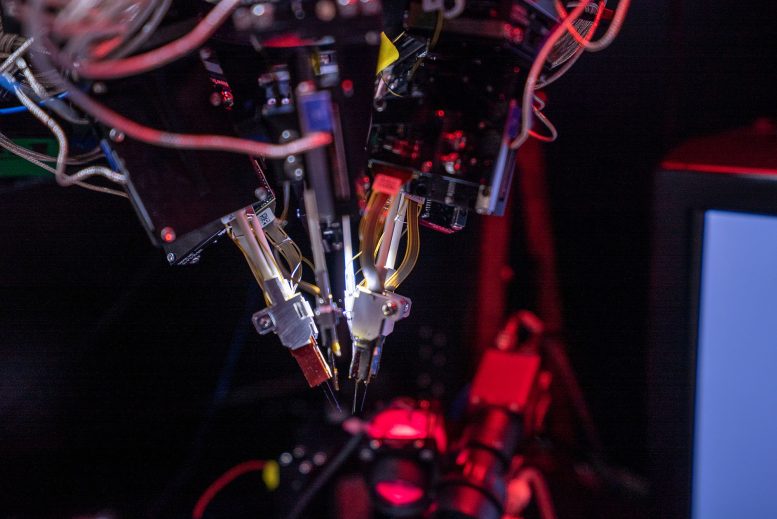Innovative Initiatives Set to Revolutionize the Future of Neuroscience

The OpenScope program by the Allen Institute provides a global platform for neuroscience research, focusing on how the brain processes everything from everyday visuals to psychedelic experiences. This initiative fosters international collaboration, utilizing advanced observatory resources to delve into fundamental neural activities and perceptions. Neuropixels probes as part of the Allen Brain Observatory pipeline. Credit: Allen Institute
How do neurons respond to the effects of magic mushrooms? What occurs in the brain during the perception of motion, or the recognition of grain patterns in wood? How does our brain monitor the gradual changes in the appearances of our friends over time?
The Allen Institute has launched four projects to investigate these questions through OpenScope, a shared neuroscience observatory. Just as astronomers use a few well-equipped observatories to study the universe, the OpenScope program lets neuroscientists worldwide propose and direct experiments on the Allen Brain Observatory pipeline. All research is made freely available to anyone tackling open questions in neural activity in health and disease.
Now in its 6th year, OpenScope aims to “pioneer a new model in neuroscience,” said Jérôme Lecoq, Ph.D., associate investigator at the Allen Institute.
“Our platform enhances data acquisition and global sharing, while empowering individual labs to leverage it for their unique scientific pursuits,” said Lecoq, who co-leads OpenScope with Christof Koch. “We’re striving to combine the best of both worlds: focused questions tackled by passionate teams, and a sophisticated platform driven by experienced experimentalists. This is our vision for the future of neuroscience.”
One of this year’s OpenScope projects will explore how psilocybin, the psychoactive compound in “magic mushrooms,” changes brain activity at a cellular level. This compound, known for inducing intense psychedelic experiences in humans, will be used to investigate the neural mechanisms that underlie altered cognition and perception.
Using advanced recording techniques in mice, scientists will observe how neurons communicate differently under the influence of psilocybin. They will also explore how those changes might influence the brain’s ability to process and predict sensory information, which is crucial to understanding how perception is constructed.
“Our interest in these compounds goes beyond their potential clinical applications,” said Roberto de Filippo, Ph.D., a postdoc at Humboldt University of Berlin. “We believe that uncovering the biological mechanisms underlying their effects can provide fundamental insights into the processes that govern perception, cognition, and consciousness itself.”
This project is being led by de Filippo; Torben Ott, Ph.D., of Humboldt University of Berlin; and Dietmar Schmitz, Ph.D, of Charité – Universitätsmedizin Berlin.
We often overlook the gradual changes in people we see regularly, only noticing differences when we view an old photo or reunite with friends after a long time. Despite these changes being almost imperceptible, our brains constantly update our memories with these details.
A 2024 OpenScope project aims to uncover the neural underpinnings of these updates. Using the Allen Brain Observatory platform, researchers will analyze brain activity in mice to understand how the brain’s visual system reacts to changes over time. Traditionally, neuroscientists thought that the visual system only processed incoming sensory information. But recent findings suggest that this system also archives visual memories and uses them to predict what we see next.
“We want to understand how such memories influence the perception of real-world visuals and what role different brain areas play in this process,” said Yaniv Ziv, Ph.D., professor at the Weizmann Institute of Science. “By understanding this, we aim to uncover whether these memories influence how flexible or rigid our visual processing is. For instance, if we’ve seen something similar before, does that make our brain more or less likely to adapt to new visual information?”
This project is being led by Ziv; Daniel Deitch; Alon Rubin, Ph.D.; and Itay Talpir, all at the Weizmann Institute of Science
How does the brain recognize objects moving around us? This 2024 OpenScope project aims to demystify this fundamental process by studying motion perception in the visual cortex of mice. While previous studies have identified brain regions that respond to different types of motion, the underlying neural circuitry remains poorly understood. This project will use microscopy to simultaneously observe the activity of many neurons over several weeks and in different parts of the visual cortex.




